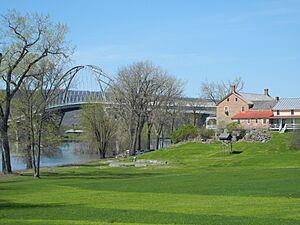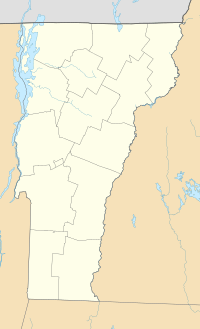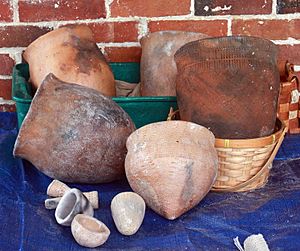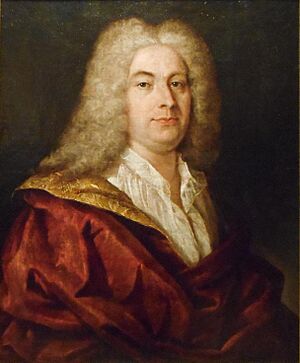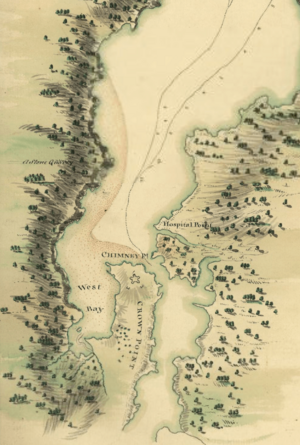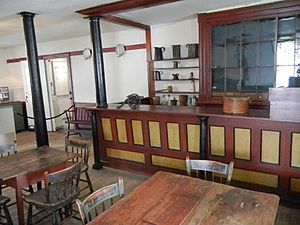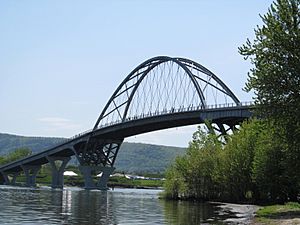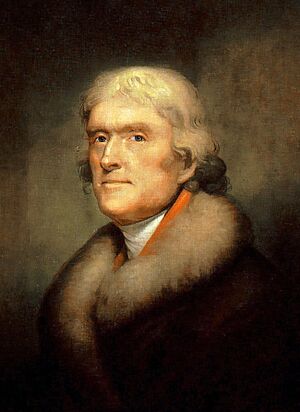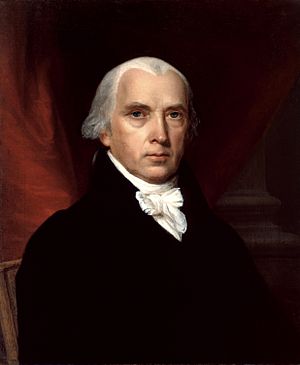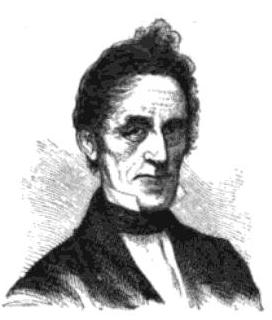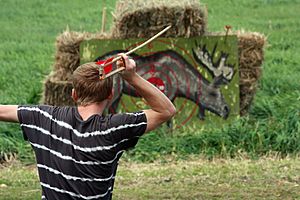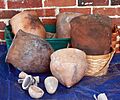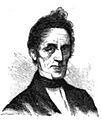Chimney Point, Vermont facts for kids
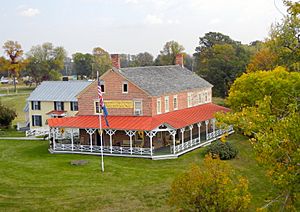
The historic tavern at Chimney Point
|
|
| Established | 1991 |
|---|---|
| Location | 8149 VT Route 17W Addison, Vermont |
| Type | History museum |
| Owner | State of Vermont |
Chimney Point is a special piece of land in Addison, Vermont. It sticks out into Lake Champlain, making the lake very narrow here. This spot has been important for thousands of years. It was one of the first places people settled in the Champlain Valley.
Native Americans lived here for a very long time. Later, in 1731, the French built forts and homes on both sides of the lake.
This area was a battleground between Great Britain and France. They both wanted control of North America. During the American Revolutionary War, American and British armies both used Chimney Point.
After the war ended in 1783, American settlers came back. In 1785, a regular ferry started crossing the lake from Chimney Point. A tavern was built, where famous people like Thomas Jefferson and James Madison once visited. It served travelers and the local community.
In 1929, the first Lake Champlain Bridge opened here. It made travel and communication between Vermont and New York much easier. This bridge was taken down in 2009 because it was old and unsafe. A new bridge opened in 2011.
Today, Chimney Point is a Vermont State Historic Site. It protects the old 1785 tavern. The site shares the stories of three different cultures: Native American, French Colonial, and early American.
Contents
What is Chimney Point Like?
The Chimney Point land is surrounded by Lake Champlain and Hospital Creek. At its narrowest, Lake Champlain is only about 0.3 miles (0.5 km) wide here. The Lake Champlain Bridge is one of only two bridges that cross the entire 125-mile (201 km) length of the lake.
This spot is a favorite place for people who like to fish. There is also a boat launch at Chimney Point. This allows people to easily get their boats into the lake.
A Look at Chimney Point's Past
Early People of Chimney Point
Scientists who study old things (archeologists) have found proof that people lived at Chimney Point for 7,500 years. Native Americans set up camps, hunted, and fished here. Their tools show they changed how they lived as the weather got warmer. They moved with the seasons to find food.
They made tools like spear throwers and stone spear points for hunting. They also made stone tools for cutting wood and other materials. During the Woodland period, Native Americans made clay pots. These pots were used to store food, water, and for cooking.
French Settlers Arrive
Samuel de Champlain was the first European to explore the lake that now carries his name. In 1609, he traveled as far south as present-day Ticonderoga. This spot is about 13 miles (21 km) from Chimney Point.
For many years, the French and English fought in North America. They wanted power, land, and control of the fur trade. Both sides had few colonists, so they made friends with Native American groups. These allies helped them in their wars.
In 1690, the British governor of New York sent Captain Jacobus de Warm. He was told to watch the French and Native Americans from Canada on Lake Champlain. De Warm built a small stone defense at Chimney Point. He, 12 soldiers, and 20 Mohawk allies stayed there for about a month.
In 1731, the French took control of the area. They first built a wooden fort (stockade) at Pointe-à-la-Chevelure, which is now Chimney Point. Around 1734 or 1735, they started building the stone Fort St. Frédéric on the west side of the lake. At first, both sides of the lake were part of one large area owned by the French king, Louis XV.
In 1743, Gilles Hocquart was given a large piece of land. It was about 115,000 acres (46,540 hectares) on the east side of the lake. This land is now much of Addison County. French settlement on Lake Champlain was for both military reasons and farming. There were farms on both sides of the lake. The number of French settlers at Chimney Point grew. It reached about 150 people at the start of the French and Indian War (1754–1763). There were 21 houses on the east side of the lake and 19 on the west.
The French and Indian War
The French settlement at Chimney Point was near major battles in the French and Indian War. These battles happened at the southern end of Lake George and at Fort Ticonderoga.
In May 1756, Major Robert Rogers scouted Fort St. Frédéric. He found that the settlements on the west side of the lake were mostly empty. He could watch the fort from across the lake. His group killed 23 cows before returning to Fort William Henry.
In the summer of 1759, British Major General Jeffery Amherst and his army took Ticonderoga. The French then went north to Canada. They blew up Fort St. Frédéric and burned houses on both sides of the lake. One chimney was left standing on the east shore. This is how the area got its new English name, Chimney Point.
On the west side of the lake, the British built a huge Fort Crown Point. It had walls 40 feet (12 m) high and a six-acre parade ground. But it was destroyed by fire in 1773. When a British engineer checked the fort in 1774, he said it was "an amazing useless mass of Earth only."
The American Revolutionary War
During the American Revolution, what happened at Chimney Point was connected to Crown Point. A small British army at Crown Point was captured by Americans in May 1775. For about a year and a half, this narrow part of the lake was an important base for the American army. It was also a base for their warships on the lake. The main headquarters was on the west side, but Chimney Point was also used. During the American retreat from Canada in 1776, sick soldiers were cared for on both sides of the lake.
In July 1776, American generals decided to move the army from Crown Point. They wanted to build new forts across from Fort Ticonderoga. This new place was later called Mount Independence. One reason for moving was that the forts at Crown Point could be easily hit by cannons from Chimney Point.
The Crown Point-Chimney Point area stayed an important outpost and naval base. This was true until the American fleet was defeated at the Battle of Valcour Island. When the British came closer in October 1776, the Americans destroyed their defenses and buildings. Settlers on both sides of the lake fled south. One person wrote that they left their homes and all their things "to the enemy, or to the flames."
The British, led by Governor General Guy Carleton, occupied the area for a few weeks in 1776. Lieutenant General John Burgoyne and his army came back to Crown Point briefly in June 1777. They then continued south to Ticonderoga and Mount Independence. German soldiers from the Duchy of Brunswick camped at Chimney Point. For the rest of the war, Chimney Point was an empty area. The British navy controlled the lake.
Ferries and Steamboats
After the Revolutionary War ended in the mid-1780s, Benjamin Paine built a tavern at Chimney Point. He also started a ferry service across the lake. By 1826, horses powered the ferry. It made regular trips to the town of Port Henry, about 3 miles (5 km) away. The tavern was later covered in brick by Asahel Barnes. His family bought the tavern in 1821.
In 1890, a steam ferry called the G.R. Sherman started making crossings. It had a much more frequent schedule. Also in the 1890s, Millard Barnes made the tavern bigger. He ran it as a summer resort called the St. Frederic Inn.
Chimney Point was also a stop for passenger steamboats that traveled on the lake.
The Bridges
The first Lake Champlain Bridge connected Chimney Point and Crown Point. It was built from June 1928 to August 1929. The bridge officially opened on August 29, 1929. About 40,000 people attended the event. Vermont Governor John E. Weeks and New York Governor Franklin D. Roosevelt met in the middle of the bridge. Roosevelt became president three years later. For 80 years, the bridge was very important for the Champlain Valley. It helped tourism and connected the two sides of the lake for business and social life.
The bridge closed suddenly on October 16, 2009. Inspectors found that the supports (piers) were badly damaged. The bridge was taken down two months later. Ferry service started again in early 2010. It carried over 1.5 million vehicles and 2.6 million passengers across the lake.
Archeologists from the University of Vermont studied the area. They worked with engineers and construction crews to protect important historical sites. Many discoveries were made at Chimney Point. These included the location of the 1731 French Fort. They also found the foundation of the chimney that likely gave the area its name.
A new Lake Champlain Bridge was built in two years. It opened on November 8, 2011. The new bridge has a different design. But its main arch looks similar to the graceful shape of the old bridge. The new bridge also has special lanes for bicycles and sidewalks for people walking.
Famous Visitors
A famous Swedish-Finnish explorer and scientist named Pehr (Peter) Kalm visited the French settlement at Chimney Point in July 1749. He stayed for more than two weeks. In his book, Travels into North America, he wrote detailed descriptions. He wrote about the lives of soldiers, the houses, Fort St. Frédéric, and the plants and animals of the area.
In 1791, future presidents Thomas Jefferson and James Madison toured upstate New York. Jefferson was Secretary of State at the time, and Madison was a Congressman. They were joined by two enslaved men, James Hemings and Matthew. On May 31, they stayed overnight in the tavern at Chimney Point. Madison wrote, "On Crown point is one family only. On the opposite side the country is well inhabited."
Chimney Point in Stories
A tavern at Chimney Point was featured in a popular book from 1839. It was a romance novel called The Green Mountain Boys: A Historical Tale of the Early Settlement of Vermont. It was written by Daniel Pierce Thompson. In the story, Green Mountain Boys leaders Ethan Allen and Charles Warrington (a made-up character based on Seth Warner) have a drinking contest with British soldiers. They do this to escape capture. Millard Barnes, who owned the St. Frederic Inn, said that the tavern in his inn was where this famous drinking contest happened. However, the tavern was built in the mid-1780s. This was about ten years after the Green Mountain Boys' adventures.
The first Lake Champlain Bridge also played a big part in the 2000 movie What Lies Beneath. This supernatural thriller was directed by Robert Zemeckis. It starred Harrison Ford and Michelle Pfeiffer. In the movie, the ghost of a murdered student is in the water under the bridge.
Chimney Point State Historic Site
In 1966, the State of Vermont bought the Chimney Point property. They wanted to protect it from being built on by private companies. In 1971, it was added to the National Register of Historic Places. This was because of its long and important history. The state fixed up the old tavern. In 1991, they opened it as a museum. It has one of the best-preserved old tap rooms and a historic rural post office.
The museum has exhibits and special events. They tell the story of the three early cultures in the Chimney Point area. These are the Native American people, the French colonists, and the early Americans after the Revolutionary War.
The park also hosts the yearly Northeast Open Atlatl Championship. Workshops are held on Native American skills. These include making atlatls (spear throwers) and darts, shaping stone tools, attaching stone points, and making rope.
Chimney Point Historic Site works closely with Crown Point State Historic Site. Crown Point is across the lake in New York. They often hold events together. Visitors can walk across the Lake Champlain Bridge from one site to the other.
The museum at the Chimney Point Historic Site is open from late May through Columbus Day.
Images for kids
See also
 In Spanish: Chimney Point para niños
In Spanish: Chimney Point para niños


